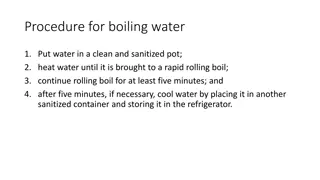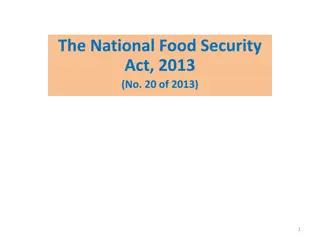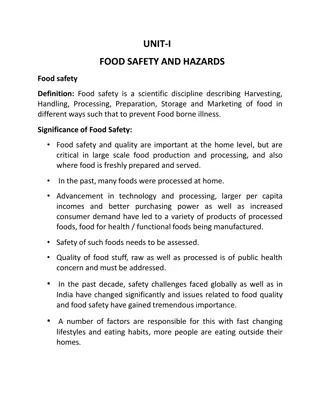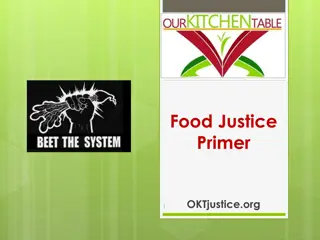The Rise of Food Trucks in the Foodservice Industry
Food trucks have emerged as the fastest-growing sub-category in the foodservice industry, with significant revenue growth and entrepreneurial opportunities. The sector has matured with the inclusion of regional associations and support services. Brick-and-mortar restaurants have also embraced food trucks as a strategic expansion tool. However, new food truck operators face challenges such as securing capital, defining their niche, and executing a solid business strategy effectively. Overcoming these obstacles is crucial for success in this dynamic industry.
Download Presentation

Please find below an Image/Link to download the presentation.
The content on the website is provided AS IS for your information and personal use only. It may not be sold, licensed, or shared on other websites without obtaining consent from the author. Download presentation by click this link. If you encounter any issues during the download, it is possible that the publisher has removed the file from their server.
E N D
Presentation Transcript
Fastest-Growing Restaurant Sub-Category Food trucks are a somewhat surprising foodservice- industry sector, in that it is the fastest-growing in the entire industry, with 2017 industry revenues forecast to reach $2.7 billion, a 315% increase since 2013 s $650 million. Today, there are an estimated 30,000 to 40,00 food trucks operating in the US. The origin of the concept (often disputed) was Roy Choi s truck selling Korean barbecue tacos on the streets of Los Angeles during 2008. The food-truck sector of the foodservice industry has matured with the addition of regional associations; which have formed the National Food Truck Association; and a growing supply chain of truck builders, software providers and event planners.
An Excellent Entrepreneurial Endeavor According to various sources, a majority of food-truck operators are entrepreneurs or independent business owners. The popular misconception is that many, if not most, food-truck owners are young adults, but most are actually older than 40. Becoming a food-truck entrepreneur is a relatively low- cost venture, typically less than $100,000, and a single truck can generate as much as $500,000 in annual revenues. Compared to many brick-and-mortar restaurants, a food-truck operation has more flexibility to experiment with new concepts and ingredients and target consumer niches by menu preferences and/or locations.
Brick-and-Mortar Restaurants Join the Caravan When food trucks began to proliferate, many brick-and- mortar restaurants were concerned. Their restaurants could lose significant market share in a city with 60 to 80 food trucks generating as much as $250,000 each in annual revenues. Some restaurants even sought relief from local governments to limit the number of food trucks; however, eventually they recognized the value of adding one or more food trucks to their business. Today, they may account for 30% to 40% of all food trucks. According to a National Restaurant Association 2015 survey, as many as 60% of brick-and-mortar restaurants said a food truck was a good strategy to expand their business. Most food trucks are serving fast-casual menu items.
Observing and Overcoming Business Obstacles According to Fast Casual s 2017 4-part series on the food truck industry, new operators face four challenges: having sufficient capital, defining their niche in a competitive market, establishing a solid business strategy and flawlessly executing that strategy. The customers of Prestige Food Trucks, which specializes in building trucks, include major fast-casual restaurant chains, government agencies, universities and thousands of independents that pay $80,000 to $120,000 per truck. Other challenges that too many newcomers to the food truck business fail to recognize are an average of $30,000 for operating capital, the reluctance of banks to finance their trucks (although SBA loans are available) and limiting their menus to 5 to 10 items.
Increasing Demand with Digital Marketing Because most food trucks serve fast-casual items, Millennials are the prime audience. Since 39% of them have ordered food via technology, the digital marketing channel, and social media, specifically, is where operator must focus their marketing efforts. Facebook, Twitter, Instagram and Snapchat are likely to be the best social media platforms for operators to connect with Millennials. LinkedIn can be very useful if a truck does most or a significant share of its business at lunchtime in downtown areas. Participation in food truck festivals is also a valuable investment. Food Truck Festivals of America (FTFA) reported that more than 100,000 guests attended its 12 2016 festivals.
Advertising Strategies Major food-truck operations, especially those from a major national or local chain, would seem to be prime candidates for an early morning news flight that promotes a daily or weekly lunch coupon available via the mobile channel. Check the Food Truck Festivals of America Website for events in your market, as TV advertising would certainly deliver an excellent ROI to attract large crowds, especially since many include featured breweries. Suggest that complementary food trucks main course items and desserts, for example share the cost of some TV advertising, which could be centered on a themed weekend or participation in a local event.
New Media Strategies Ask people to nominate a friend/family member/co- worker to have a menu item named in his or her honor as a monthly or quarterly promotion. His or her name is added to the menu board and promoted on social media. Create a scavenger hunt with clues on the truck and/or at the locations where the truck will be parked during a day or weekend. Participants must take a picture or record video each time they find a clue and in front of the truck with the name visible. Host a contest in which the winner works at the food truck for a day. Ask people on Twitter to state why they should be selected with 140 characters or less. Make sure to take photos and record videos throughout the day and upload them to social media.























